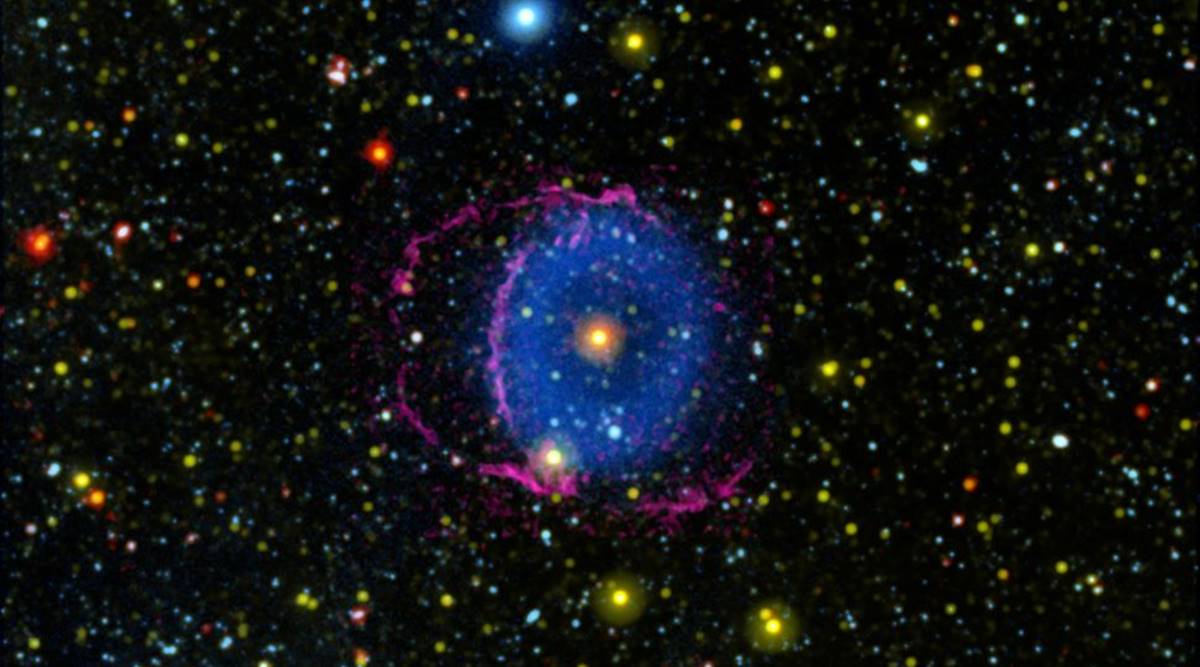 Blue ring nebula discovered in 2004 (Image credit: NASA/JPL-Caltech/M. Seibert (Carnegie Institution for Science)/K. Hoadley (Caltech)/GALEX Team)
Blue ring nebula discovered in 2004 (Image credit: NASA/JPL-Caltech/M. Seibert (Carnegie Institution for Science)/K. Hoadley (Caltech)/GALEX Team)Scientists have finally found a valid explanation for the Blue Ring Nebula that surrounds a central star, known as TYC 2597-735-1 which is 6,000 light-years away from Earth. It was 16 years ago, astronomers came across the strange ultraviolet ring (colour-coded blue) surrounding the star with the help of NASA’s Galaxy Evolution Explorer (GALEX) space telescope which is now defunct. Since then there have been plenty of speculations but none have come close to explaining the phenomenon.
“Every time we thought we had this thing figured out, something would tell us, ‘No, that’s not right,'” Mark Seibert, an astrophysicist with the Carnegie Institution for Science, a member of the GALEX team and a co-author on the new research, said in a statement. “That’s a scary thing as a scientist. But I also love how unique this object is, and the effort that so many people put in to figure it out.”
The recent research using the W. M. Keck Observatory in Hawaii has revealed that that the ring surrounding the star is nothing but two cone-shaped glowing clouds made of molecular hydrogen extending away from the star on opposite sides. These clouds form an illusion of a ring when observed from our planet.
The research was made public on Wednesday and the scientists involved believe that the fluorescent debris is a result of a collision with a sun-like star a few thousand years ago.
“The merging of two stars is fairly common, but they quickly become obscured by lots of dust as the ejecta from them expands and cools in space, which means we can’t see what has actually happened,” the lead author of the study and a physicist at Caltech, Keri Hoadley said in the statement.
The timing was of the essence in the new research as it explained the reason behind the phenomenon. “We think this object represents a late stage of these transient events, when the dust finally clears and we have a good view,” Hoadley said. “But we also caught the process before it was too far along; after time, the nebula will dissolve into the interstellar medium, and we would not be able to tell anything happened at all.”
The major collision led to the ejection of a cloud made of hot debris into space and as it reached outwards. A shock wave was created which further led to hydrogen molecules in the cloud to heat up. This chain of events produced ultraviolets emissions which were observed in 2004 and had scientists scratching their heads trying to find an explanation.
During the research, scientists were also able to get their hands on the archived data from NASA’s Spitzer Space Telescope and the Wide-field Survey Explorer (WISE). It helped them understand that the disk of dust surrounding the star absorbs its energy followed by reradiation in the infrared. It is also believed that the disk is the reason behind cutting the cloud of debris into half which is visible now in the shape of two cones.
Express Tech is now on Telegram. Click here to join our channel (@expresstechie) and stay updated with the latest tech news.